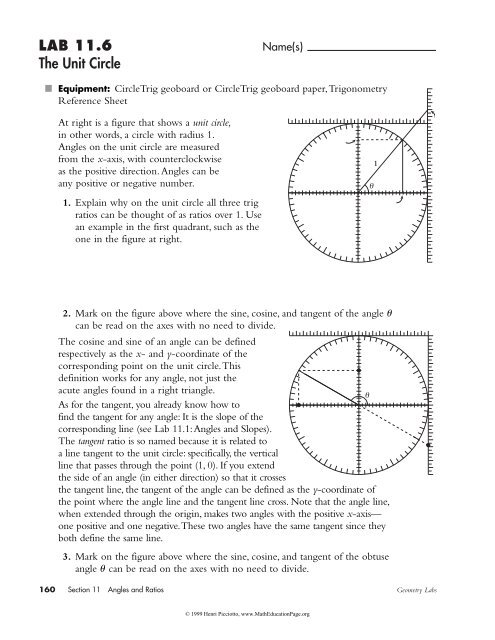Create successful ePaper yourself
Turn your PDF publications into a flip-book with our unique Google optimized e-Paper software.
LAB 11.6<br />
The Unit Circle<br />
Name(s)<br />
Equipment: CircleTrig geoboard or CircleTrig geoboard paper,Trigonometry<br />
Reference Sheet<br />
At right is a figure that shows a unit circle,<br />
in other words, a circle with radius 1.<br />
Angles on the unit circle are measured<br />
from the x-axis, with counterclockwise<br />
as the positive direction. Angles can be<br />
any positive or negative number.<br />
1<br />
1. Explain why on the unit circle all three trig<br />
ratios can be thought of as ratios over 1. Use<br />
an example in the first quadrant, such as the<br />
one in the figure at right.<br />
2. Mark on the figure above where the sine, cosine, and tangent of the angle <br />
can be read on the axes with no need to divide.<br />
The cosine and sine of an angle can be defined<br />
respectively as the x- and y-coordinate of the<br />
corresponding point on the unit circle.This<br />
definition works for any angle, not just the<br />
acute angles found in a right triangle.<br />
As for the tangent, you already know how to<br />
find the tangent for any angle: It is the slope of the<br />
corresponding line (see Lab 11.1:Angles and Slopes).<br />
The tangent ratio is so named because it is related to<br />
a line tangent to the unit circle: specifically, the vertical<br />
line that passes through the point (1, 0). If you extend<br />
the side of an angle (in either direction) so that it crosses<br />
the tangent line, the tangent of the angle can be defined as the y-coordinate of<br />
the point where the angle line and the tangent line cross. Note that the angle line,<br />
when extended through the origin, makes two angles with the positive x-axis—<br />
one positive and one negative.These two angles have the same tangent since they<br />
both define the same line.<br />
3. Mark on the figure above where the sine, cosine, and tangent of the obtuse<br />
angle can be read on the axes with no need to divide.<br />
160 Section 11 Angles and Ratios Geometry Labs<br />
© 1999 Henri Picciotto, www.MathEducationPage.org






